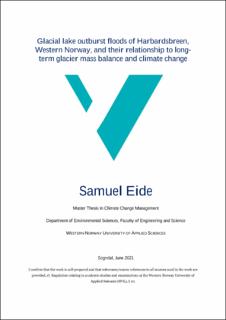| dc.description.abstract | In this study I have used various sources of satellite imagery to present long term changes of the two glacial lakes of Harbardsbreen, Luster municipality, Western Norway. I have made a time series which ranges from the first Landsat-1 satellite in 1972 to 2020. For the period 2010-2020 I have done a detailed study of the annual developments of the lakes to find evidence of glacial lake outburst floods (GLOFs). NVE’s GLOF database shows registered and documented GLOF events at Harbardsbreen in 2010, 2012, 2015 and 2020. In this study, I additionally found evidence with high certainty of GLOF events in 2011, 2018 and in 2019, a probable GLOF event in 2014 and possible GLOF events in 2013 and 2017. In the period 2010-2020, 2016 was the only year in which neither of the two lakes at Harbardsbreen formed, likely due to the weather conditions this season.
Harbardsbreen has melted and thinned significantly in the period 2010-2020, with an average mass balance of -5.3 ± 0.6 meters water equivalents (m.w.e.), or -0.53 ± 0.06 m.w.e. per year. This is less negative than for the period 1996-2010 (-0.82 ± 0.05 m.w.e. a-1) (Andreassen L. M., 2013), but more negative than the period 1966-1996 (-0.28 ± 0.07 m.w.e. a-1) (Kjøllmoen B. , 1997). The lakes seem to be linked to this pattern, in the period 1996-2010 the average maximum known extent of the largest lake was 34% and 29% larger than in the periods 1966-1996 and 2010-2020 respectively.
I have proposed a possible early warning of GLOF events at Harbardsbreen. All the GLOF events in 2010, 2011, 2015 and 2020 shared the same characteristics in both lake development, size and weather data. However, it is evident that GLOFs also can occur at smaller lake extents/volumes (e.g. 2018 and 2019). Therefore, I have proposed a probable certainty of GLOF events for lake extents in the magnitude of 104 m2, and high certainty of GLOF events for lake extents in the magnitude of 105 m2. The risk will increase by the lake extent. | en_US |

